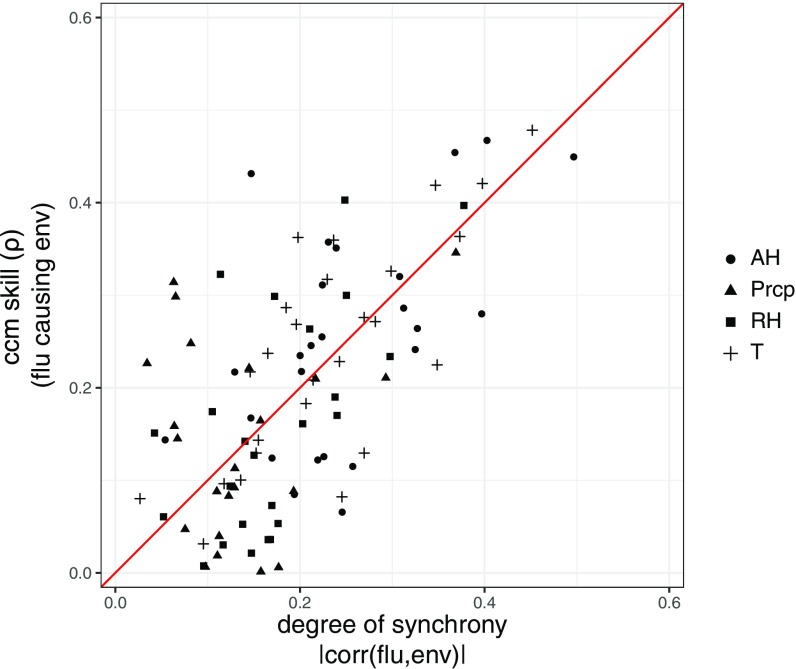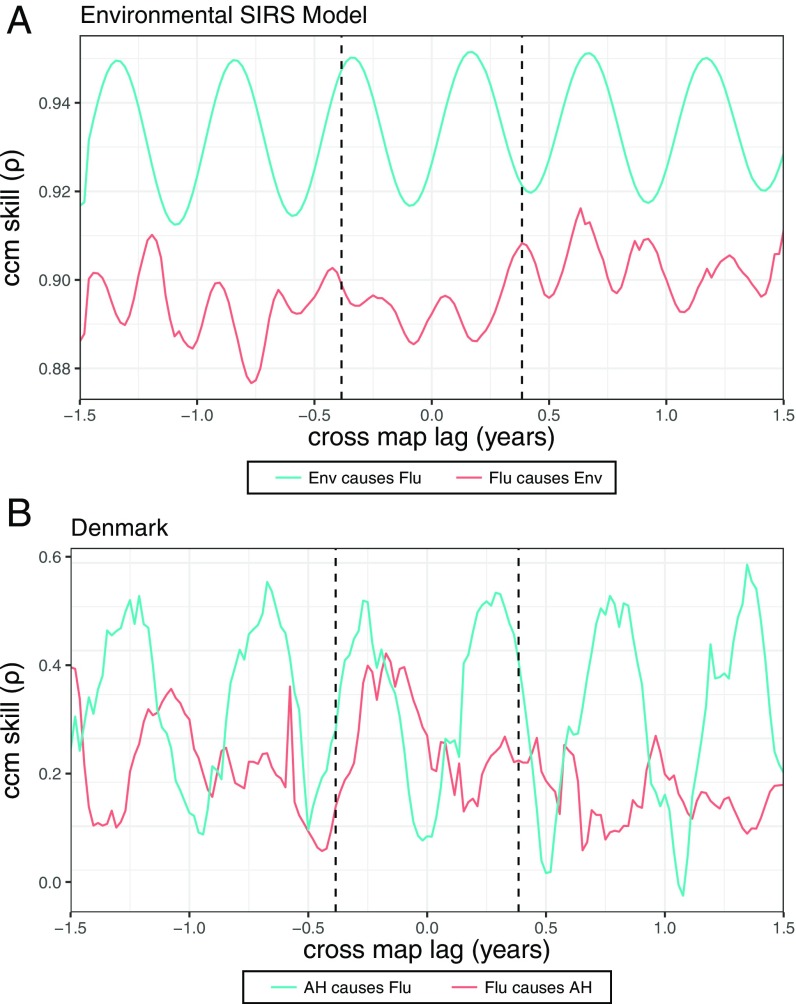Baskerville and Cobey (1) caution against convergent cross-mapping (CCM) as a test for causation. However, their argument is based on an incorrect application of CCM arising from misconceptions about causation with synchrony.
As stated in Deyle et al. (2), it is widely believed that there is synchrony between flu incidence and seasonal environmental drivers such as absolute humidity (AH). Synchrony is a well-studied phenomenon that can result from strong coupling or dynamic resonance. In unidirectionally driven systems synchrony can arise when the affected variable becomes effectively enslaved to the driving variable so that their dynamics become indistinguishable. As explained in Sugihara et al. (3), this leads to the false appearance of bidirectional causality (one direction being nonsensical). Thus, with synchrony the direction of causation is obscured.
This well-understood fact about CCM explains the observations made in ref. 1 and why their attempt to use directionality as a litmus test was incorrect. To confirm this, Fig. 1 shows that the apparent effect of flu on AH is largely explained by synchrony (measured by how strongly correlated flu is to the environment)—exactly as expected.
Fig. 1.
CCM skill for the effect of influenza on the environment is strongly determined by the degree of synchrony (the maximum lagged correlation between influenza and the environmental variable). Points correspond to the 26 countries studied in ref. 2. PRCP, precipitation; RH, relative humidity; and T, temperature.
With synchrony, basing a test on the directionality of CCM only makes sense if there are unambiguous time delays between cause and effect (4). However, Fig. 2 shows how a lag test fails if the environmental driver is strongly periodic—resulting in the absence of a uniquely optimal cross-map lag to use for a directionality test.
Fig. 2.
CCM skill (ρ) as a function of cross-map lag (negative values indicate that causes precede effects). (A) The susceptible–infected–recovered–susceptible (SIRS) model with synchrony between flu and a periodic driver shows no well-defined optimal lag. (B) An empirical example showing the same pattern. Note that selecting the lag with the maximum CCM value over the window used in ref. 1 (dashed lines) obscures the fact that the optimal lag is not unique and thus has little information about the direction of causation.
These facts do not mean that CCM “has gone awry” but simply that the interpretation in ref. 1 is misinformed. A more pertinent test of causation is described in Deyle et al. (2). It addresses the concern that two noninteracting variables (e.g., flu and AH) may both be independently synchronized to the seasonal cycle (i.e., case 3 as described in ref. 3). The test developed in ref. 2 using seasonal surrogates specifically shows that there is evidence beyond synchrony that environmental variables have a causal effect on flu.
Thus, the analysis in ref. 1 demonstrates the well-known difficulty of establishing directionality in synchronous systems; however, it has no relevance to and does not contradict the findings of ref. 2. Indeed, directionality is not itself a pertinent question (we know that flu does not drive humidity). Instead, the most important validation of the results will come from experiments to determine whether the U-shaped effect of humidity (5) and the discovered temperature threshold are valid [i.e., below 75 °F (in temperate regions) humidity has a negative effect on flu incidence, whereas at higher temperatures (in the tropics) humidity promotes flu incidence].
Footnotes
The authors declare no conflict of interest.
References
- 1.Baskerville EB, Cobey S. Does influenza drive absolute humidity? Proc Natl Acad Sci USA. 2017;114:E2270–E2271. doi: 10.1073/pnas.1700369114. [DOI] [PMC free article] [PubMed] [Google Scholar]
- 2.Deyle ER, Maher MC, Hernandez RD, Basu S, Sugihara G. Global environmental drivers of influenza. Proc Natl Acad Sci USA. 2016;113(46):13081–13086. doi: 10.1073/pnas.1607747113. [DOI] [PMC free article] [PubMed] [Google Scholar]
- 3.Sugihara G, et al. Detecting causality in complex ecosystems. Science. 2012;338(6106):496–500. doi: 10.1126/science.1227079. [DOI] [PubMed] [Google Scholar]
- 4.Ye H, Deyle ER, Gilarranz LJ, Sugihara G. Distinguishing time-delayed causal interactions using convergent cross mapping. Sci Rep. 2015;5:14750. doi: 10.1038/srep14750. [DOI] [PMC free article] [PubMed] [Google Scholar]
- 5.Yang W, Elankumaran S, Marr LC. Relationship between humidity and influenza A viability in droplets and implications for influenza’s seasonality. PLoS One. 2012;7(10):e46789. doi: 10.1371/journal.pone.0046789. [DOI] [PMC free article] [PubMed] [Google Scholar]




